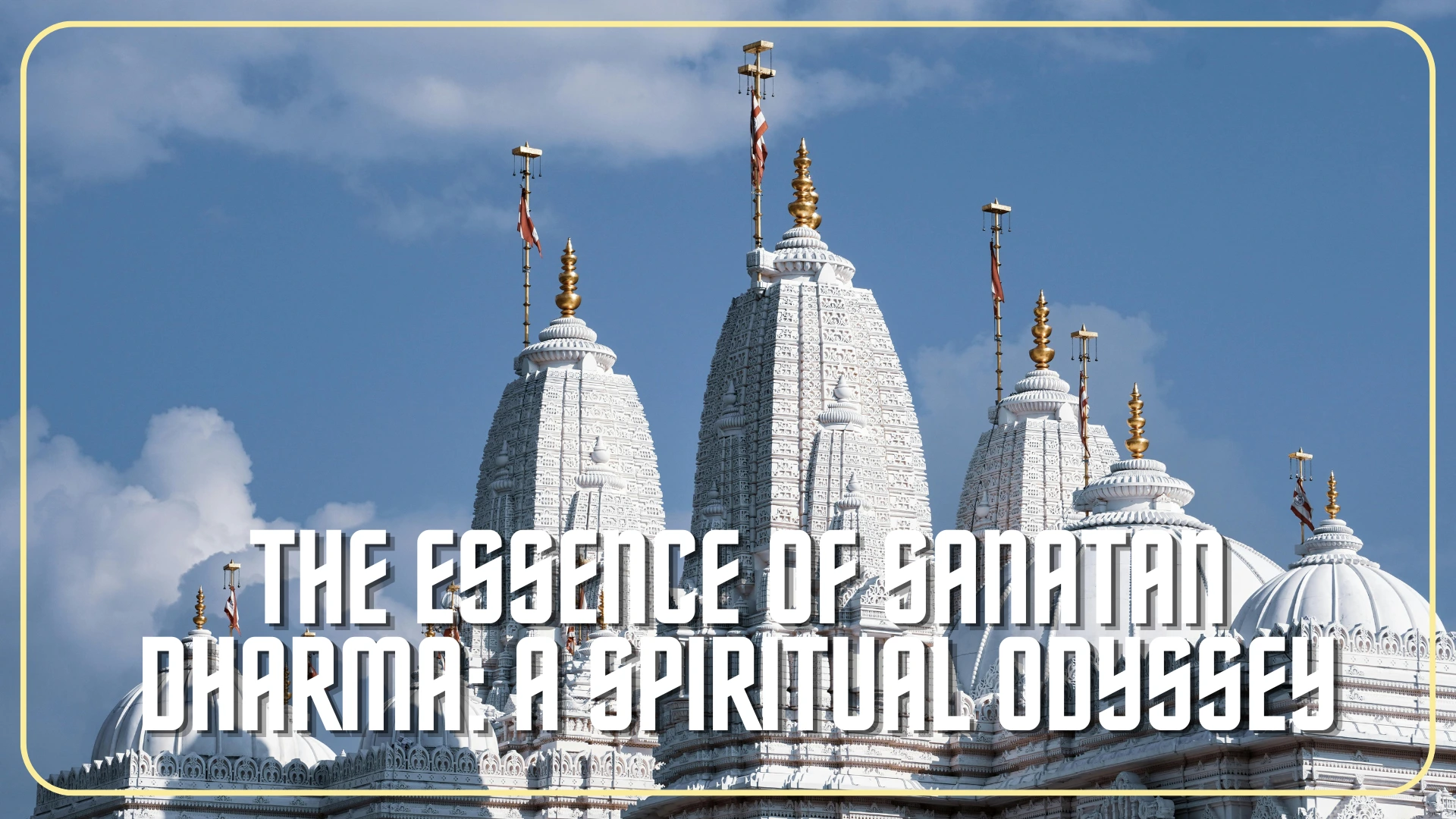What is Sanatan Dharma
Sanatan Dharma, often referred to as Hinduism, is not merely a religion; it is a way of life that has withstood the test of time, weaving its spiritual tapestry through the ages. In this article, we delve into the depths of Sanatan Dharma, exploring its rich history, philosophical underpinnings, and the profound impact it has had on the cultural landscape of India.
Historical Roots
The term “Sanatan Dharma” translates to the “eternal path” or the “eternal order.” Its origins can be traced back thousands of years, with a diverse range of scriptures forming the foundation of this ancient tradition. The Vedas, Upanishads, Bhagavad Gita, and Puranas are among the sacred texts that encapsulate the philosophical wisdom, rituals, and narratives that define Sanatan Dharma.
Philosophical Foundations
At the heart of Sanatan Dharma lies a profound philosophical framework that encompasses various paths to spiritual realization. The concept of Dharma, which refers to righteous duty and moral order, is central to Hindu philosophy. The pursuit of four primary goals, known as Purusharthas — Dharma (righteousness), Artha (wealth and prosperity), Kama (desire), and Moksha (liberation) — provides a comprehensive guide to leading a balanced and fulfilling life.
Theology and Deities
Sanatan Dharma is renowned for its diverse pantheon of gods and goddesses, each representing different aspects of the divine. From Brahma, the creator, to Vishnu, the preserver, and Shiva, the destroyer, Hinduism acknowledges the cyclical nature of existence. Devotees engage in a myriad of rituals, ceremonies, and festivals that honour these deities, fostering a deep sense of spiritual connection.
Rituals and Practices
The tapestry of Sanatan Dharma is woven with intricate rituals and practices that vary across regions and communities. From the daily recitation of prayers (puja) to elaborate ceremonies and festivals, these rituals serve as a means of expressing devotion, seeking divine blessings, and fostering a sense of community.
Spiritual Paths
Sanatan Dharma offers diverse spiritual paths catering to the temperament and inclination of individuals. The paths of Karma Yoga (selfless action), Bhakti Yoga (devotion), Jnana Yoga (knowledge), and Raja Yoga (meditation) provide seekers with a range of approaches to attaining spiritual enlightenment.
Cultural Impact
Beyond its religious and philosophical dimensions, Sanatan Dharma has profoundly shaped the cultural fabric of India. Its influence is evident in classical art, music, dance, architecture, and even in the everyday rituals that colour the lives of millions.
Sacred Scriptures and Wisdom
Sanatan Dharma draws its essence from a vast repository of sacred scriptures, each offering a unique perspective on life, ethics, and spirituality. The Vedas, the oldest of these texts, are a source of hymns, rituals, and philosophical insights. The Upanishads delve into the nature of reality and the self, providing a foundation for spiritual exploration. The Bhagavad Gita, set in the epic Mahabharata, serves as a dialogue between Lord Krishna and Arjuna, imparting profound teachings on duty and righteousness.
Cycle of Birth and Rebirth (Samsara)
Central to Hindu philosophy is the concept of Samsara, the cycle of birth, death, and rebirth. Individuals are believed to undergo this continuous cycle until they achieve Moksha, liberation from the material world. The law of Karma, which governs actions and their consequences, plays a crucial role in determining the course of one’s journey through Samsara.
Yugas and Cosmic Cycles
Sanatan Dharma introduces the concept of Yugas, or cosmic ages, which cyclically repeat over time. The four Yugas – Satya, Treta, Dvapara, and Kali – signify different levels of spiritual development and societal virtues. Understanding these cycles provides a profound insight into the cyclical nature of cosmic evolution.
Symbolism and Rituals
Symbolism is integral to the practice of Sanatan Dharma. The sacred syllable “Om,” the lotus flower, and the third eye of Lord Shiva are among the myriad symbols that hold deep spiritual significance. Rituals, conducted with precision and devotion, often involve the chanting of mantras, the lighting of lamps, and the offering of specific items to deities.
Festivals and Celebrations
Sanatan Dharma is a tapestry of festivals that celebrate diverse aspects of life, mythology, and nature. Diwali, the festival of lights, Holi, the festival of colors, and Navaratri, dedicated to the goddess Durga, are among the vibrant celebrations that bring communities together in joy and devotion.
Diversity in Unity
One of the remarkable aspects of Sanatan Dharma is its ability to accommodate a diverse range of beliefs and practices. While there are common threads that bind the tradition together, the flexibility allows for a multitude of interpretations, rituals, and spiritual paths. This diversity is a testament to the inclusive nature of the tradition.
Impact on Daily Life
Beyond the grandeur of temples and philosophical discourses, Sanatan Dharma is woven into the fabric of everyday life. From the sacred rituals performed in homes to the reverence for nature and all living beings, the influence of this ancient tradition is palpable in the daily lives of its followers.
Dharma in Action
At the core of Sanatan Dharma is the concept of Dharma, often described as a righteous duty or moral order. Dharma extends beyond personal conduct; it encompasses societal responsibilities and ethical governance. The epics, such as the Ramayana and Mahabharata, vividly depict characters grappling with dilemmas of Dharma, emphasizing the nuanced nature of moral choices.
Meditation and Yogic Practices
Sanatan Dharma places significant importance on meditation and yogic practices as pathways to spiritual realization. Raja Yoga, the science of meditation, encourages seekers to delve deep into their consciousness, fostering self-awareness and inner peace. Various yogic disciplines, including Hatha Yoga and Kundalini Yoga, offer practical methods for physical and mental well-being.
Ahimsa and Compassion
Ahimsa, the principle of non-violence, is a cornerstone of Sanatan Dharma. Rooted in compassion, this principle extends to all living beings, emphasizing the interconnectedness of life. Mahatma Gandhi, influenced by Hindu philosophy, employed the concept of Ahimsa in the pursuit of India’s independence, showcasing the real-world impact of these ancient ideals.
Bhakti Movement and Devotional Practices
The Bhakti movement, which gained prominence in medieval India, emphasized the path of devotion to a personal deity. Saints like Kabir, Mirabai, and Tulsidas played pivotal roles in popularizing devotional practices that transcended societal boundaries, fostering a direct and personal connection with the divine.
Science and Spirituality
Contrary to the perception of science and spirituality as incompatible, Sanatan Dharma harmonizes these seemingly divergent realms. Ancient texts like the Vedas contain insights into astronomy, mathematics, and medicine. The pursuit of knowledge (Jnana Yoga) is seen as a sacred endeavor, with the understanding that science and spirituality can coexist.
Pilgrimages and Sacred Sites
Pilgrimages hold a special place in the practice of Sanatan Dharma, with devotees embarking on journeys to sacred sites across India. From the Himalayan shrines to the banks of the Ganges, these pilgrimages provide a physical and spiritual odyssey, fostering a deep connection with the divine and the natural world.
Living in Harmony with Nature
Sanatan Dharma recognizes the sacredness of nature and emphasizes the interconnectedness of all living beings. The reverence for rivers, mountains, and forests is not merely symbolic; it translates into a sustainable way of life, encouraging environmental stewardship and ethical treatment of the Earth.
Role of Gurus and Spiritual Teachers
Gurus, or spiritual teachers, play a pivotal role in guiding seekers on their spiritual journey. The relationship between a disciple and a guru is regarded as sacred, with the guru imparting knowledge, wisdom, and spiritual practices to the disciple. This tradition underscores the importance of experiential learning and the transmission of spiritual wisdom.
Adapting Tradition to Modern Life
In the face of modern challenges, adherents of Sanatan Dharma navigate a delicate balance between tradition and adaptability. The principles remain timeless, yet their application evolves to address contemporary issues, reflecting the dynamic nature of this ancient tradition.
Modern Challenges and Relevance
In a rapidly changing world, Sanatan Dharma grapples with the challenges of modernity. However, its timeless principles continue to offer guidance on leading a balanced and purposeful life, addressing contemporary issues with a blend of tradition and adaptability.
Final Reflections
Sanatan Dharma is a living, breathing philosophy that transcends the confines of dogma. Its tapestry is woven with threads of wisdom, compassion, and a profound understanding of the human experience. As we continue to explore the depths of Sanatan Dharma, we uncover not just a religious tradition but a holistic guide for navigating the complexities of existence, fostering spiritual growth, and embodying the eternal truths that resonate across time and space.
In Conclusion
Sanatan Dharma is more than a religious system; it is a comprehensive guide to navigating the complexities of existence. As we immerse ourselves in the wisdom of its scriptures, embrace its rituals, and celebrate its festivals, we embark on a transformative journey that transcends the boundaries of time and space. In the tapestry of Sanatan Dharma, we find not just a belief system but a holistic way of life that resonates with the eternal quest for truth, meaning, and self-realization. Sanatan Dharma stands as a testament to the enduring spirit of India, encapsulating a profound philosophy, rich mythology, and a diverse array of cultural expressions. As we navigate the labyrinthine depths of this ancient tradition, we discover not just a religion but a timeless journey toward self-discovery and spiritual awakening. In embracing the teachings of Sanatan Dharma, one finds a guide to harmonizing the complexities of life and realizing the eternal truths that transcend the boundaries of time and space.



